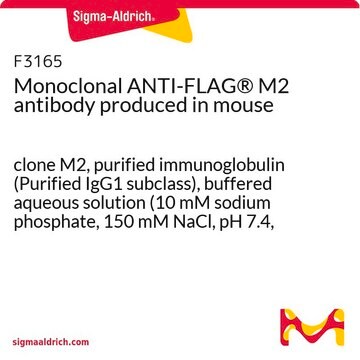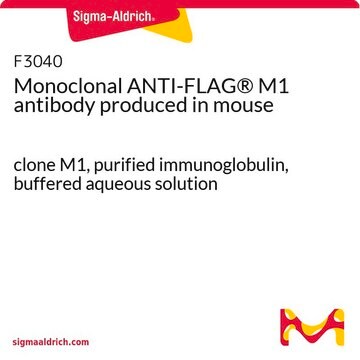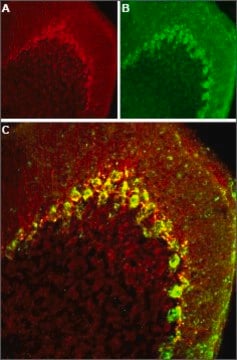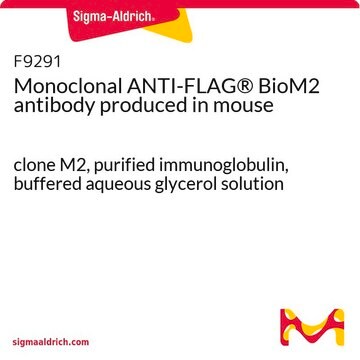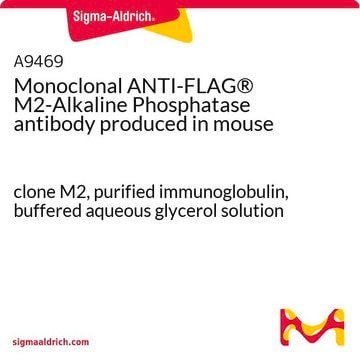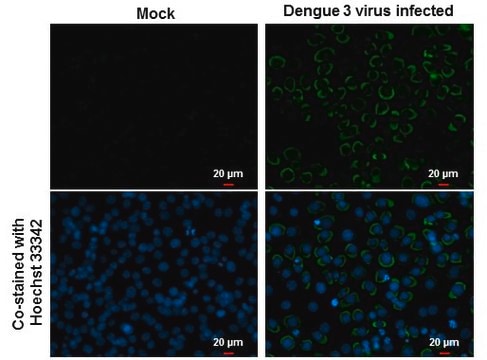SAB4200071
ANTI-FLAG® antibody, Rat monoclonal
clone 6F7, purified from hybridoma cell culture
Sinonimo/i:
Anti-ddddk, Anti-dykddddk
Scegli un formato
CHF 576.00
Scegli un formato
About This Item
CHF 576.00
Prodotti consigliati
Origine biologica
rat
Coniugato
unconjugated
Forma dell’anticorpo
purified from hybridoma cell culture
purified immunoglobulin
Tipo di anticorpo
primary antibodies
Clone
6F7, monoclonal
Stato
buffered aqueous solution
Reattività contro le specie
all
tecniche
immunoprecipitation (IP): 2.5-5.0 μg using lysates of transiently transfected cells expressing C-terminal-FLAG-tagged protein
western blot: 0.5-1.0 μg/mL using extracts of transiently transfected cells expressing C-terminal-FLAG-tagged protein
Isotipo
IgG1
Sequenza immunogenica
(DYKDDDDK)
Condizioni di spedizione
dry ice
Temperatura di conservazione
−20°C
Descrizione generale
Monoclonal Anti-FLAG® recognizes N-terminal,
C-terminal and internal Flag-tagged fusion proteins. The product is especially recommended for identifying C-terminal FLAG®-tagged fusion proteins.
Epitope tags provide a method to localize gene products in a variety of cell types, study the topology of proteins and protein complexes, identify associated proteins, and characterize newly identified, low abundance, or poorly immunogenic proteins when protein specific antibodies are not available. Tagging with the FLAG® peptide sequence may be done at the N-terminus, N-terminus preceded by a methionine residue, C-terminus, or at internal positions of the target protein. FLAG may also be placed in associationith other tags.[1] The small size of the FLAG® tag or sequence and its high hydrophilicity tend to decrease the possibility of interference with the protein expression, proteolytic maturation, antigenicity, and function.
The N-terminal FLAG® peptide sequence contains a unique enterokinase cleavage site allowing it to be completely removed from the purified fusion proteins. Cleavage of the C-terminal FLAG® peptide from a fusion protein catalyzed by Cu2+ ions has been reported.[2] A sequence motif with five out of eight amino acid residues identical to the FLAG peptide is found in both rat and mouse Mg2+dependent protein b-phosphatase[3], as well as in the human and bovine enzyme.
Immunogeno
DYKDDDDK
Applicazioni
- chromatin immunoprecipitation (ChIP)[4]
- western blotting[5]
- coimmunoprecipitation[6][7]
- flow cytometric analysis[7]
Stato fisico
Note legali
Non trovi il prodotto giusto?
Prova il nostro Motore di ricerca dei prodotti.
Codice della classe di stoccaggio
10 - Combustible liquids
Punto d’infiammabilità (°F)
Not applicable
Punto d’infiammabilità (°C)
Not applicable
Scegli una delle versioni più recenti:
Certificati d'analisi (COA)
Non trovi la versione di tuo interesse?
Se hai bisogno di una versione specifica, puoi cercare il certificato tramite il numero di lotto.
Possiedi già questo prodotto?
I documenti relativi ai prodotti acquistati recentemente sono disponibili nell’Archivio dei documenti.
I clienti hanno visto anche
Active Filters
Il team dei nostri ricercatori vanta grande esperienza in tutte le aree della ricerca quali Life Science, scienza dei materiali, sintesi chimica, cromatografia, discipline analitiche, ecc..
Contatta l'Assistenza Tecnica.